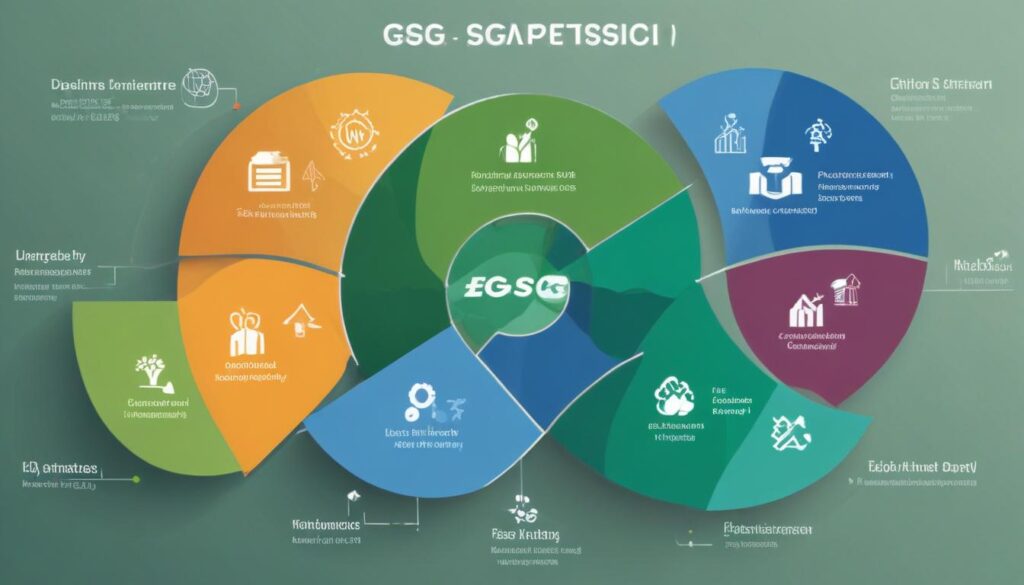ESG performance indicators are essential metrics that assess a company’s sustainability efforts in environmental, social, and governance areas, ultimately influencing financial performance and reputation, while providing insights for risk management and stakeholder engagement.
Have you ever wondered how esg performance indicators shape business strategies today? In this article, we’ll delve into their crucial distinctions and significance.
What are ESG indicators and why are they important?
ESG indicators are essential tools used to evaluate a company’s performance in areas related to environmental, social, and governance factors. These indicators provide insights that help investors, stakeholders, and the public assess a company’s commitment to sustainable practices.
Understanding ESG indicators is crucial as they help identify how well a company manages risks and opportunities surrounding environmental issues, such as climate change, social responsibilities, and corporate governance.
Some key aspects of ESG indicators include:
- Environmental factors: Metrics may include carbon emissions, energy usage, waste management, and water usage.
- Social factors: These address issues like employee treatment, community engagement, diversity and inclusion, and supply chain standards.
- Governance factors: Governance metrics involve board diversity, corporate ethics, compliance policies, and shareholder rights.
Data from these indicators is often used in investment analysis, allowing investors to make decisions that align with their values and risk thresholds. Companies that excel in ESG practices are typically viewed as more sustainable, which can lead to better financial performance in the long run.
The relevance of ESG indicators continues to grow as consumers and investors alike demand transparency regarding corporate practices. By focusing on these metrics, organizations can enhance their reputation, achieve operational efficiencies, and build customer loyalty.
Source: Global Reporting Initiative, Sustainability Accounting Standards Board
How do ESG measures differ from performance metrics?

Understanding the distinction between ESG measures and performance metrics is crucial for businesses aiming to enhance their sustainability practices effectively. ESG measures focus specifically on evaluating how well a company addresses environmental, social, and governance issues, while performance metrics often include a broader range of financial and operational indicators.
ESG measures typically assess the company’s commitment to sustainability and its impact on stakeholders. For instance, they might reflect metrics such as carbon emissions, employee diversity, or governance structure, which provide insight into risk management and ethical practices.
On the other hand, performance metrics generally cover key performance indicators (KPIs) relating to financial health, such as profitability, revenue growth, and operational efficiency. These metrics are essential for investors as they indicate the company’s overall performance in the marketplace.
A clear understanding of which metrics to apply can foster better decision-making. Companies that integrate both ESG measures and traditional performance metrics can develop a more comprehensive view of their operational effectiveness and reputational integrity.
To illustrate the differences, consider the following:
- ESG Measures: Carbon footprint reduction, community engagement levels, board diversity.
- Performance Metrics: Revenue growth percentage, profit margin, return on investment (ROI).
By recognizing that these two sets of indicators serve different purposes, organizations can align their strategies to not only enhance financial results but also build trust and accountability with their stakeholders.
Source: Principles for Responsible Investment, Global Reporting Initiative
What are the most common ESG performance indicators used today?
Identifying the most common ESG performance indicators is vital for companies aiming to assess and improve their sustainability efforts. These indicators provide measurable data that reflect the effectiveness of a company’s strategies regarding environmental, social, and governance factors.
Among the most widely used ESG performance indicators are:
- Carbon Emissions: This metric tracks a company’s greenhouse gas emissions, providing insight into its environmental impact.
- Water Usage: Monitoring water consumption helps organizations understand their resource efficiency and manage risks related to water scarcity.
- Diversity and Inclusion: Evaluating the diversity of a company’s workforce, including gender and racial representation, highlights its commitment to social equity.
- Employee Turnover Rates: This measure indicates workforce stability and satisfaction, which are crucial for social sustainability.
- Board Diversity: Assessing the composition of boards can provide insights into governance practices and the company’s commitment to diverse leadership.
These indicators not only help businesses fulfill regulatory requirements but also enhance reputation and attract socially conscious investors. Additionally, companies that effectively leverage these metrics can identify areas for improvement, drive operational efficiency, and mitigate risks.
In today’s corporate landscape, the emphasis on ESG performance indicators is increasing. Stakeholders demand transparency and accountability, making it essential for organizations to track and report on these metrics.
Source: Global Reporting Initiative, Sustainability Accounting Standards Board
Understanding the significance of ESG metrics in business strategy

Understanding the significance of ESG metrics in business strategy is essential for organizations looking to thrive in today’s competitive environment. These metrics provide valuable insights into a company’s performance regarding environmental, social, and governance factors, influencing decision-making and strategic planning.
Implementing ESG metrics allows businesses to identify risks and opportunities related to sustainability. For example, companies that monitor their carbon footprint can discover ways to reduce costs and enhance operational efficiency. Likewise, assessing employee satisfaction and community impact fosters a positive workplace culture and strengthens stakeholder relationships.
Moreover, integrating ESG metrics into business strategy can lead to improved financial performance. Studies have shown that companies with strong ESG practices often experience higher returns, as they attract socially conscious investors and build consumer loyalty. As such, stakeholders increasingly expect transparency in ESG performance, making it a critical component of corporate accountability.
Key advantages of leveraging ESG metrics in strategy include:
- Enhanced Reputation: Organizations demonstrating a commitment to sustainability can improve their market image.
- Risk Management: Companies can proactively address potential risks associated with environmental regulations and social issues.
- Attracting Talent: A strong ESG commitment can help attract and retain top talent.
Incorporating these metrics into every aspect of business planning not only aligns organizations with consumers’ values but also prepares them for the evolving regulatory landscape. Therefore, understanding and utilizing ESG metrics is pivotal for long-term success.
Source: Harvard Business Review, World Economic Forum
Exploring the relationship between ESG and financial performance
Exploring the relationship between ESG factors and financial performance reveals critical insights for businesses aiming to enhance their market position. Numerous studies suggest a positive correlation between strong ESG practices and improved financial outcomes, indicating that companies prioritizing sustainability often outperform their peers.
Investors are increasingly aware that firms with robust ESG frameworks tend to demonstrate lower risks and higher returns. Effective sustainability practices can lead to operational efficiencies, reduce costs, and foster innovation. For instance, organizations that minimize energy consumption or waste effectively can significantly decrease their operational expenses.
Moreover, strong ESG performance can enhance a company’s reputation, attracting socially conscious investors and consumers. A positive public image can translate to increased sales, customer loyalty, and overall market share. Businesses that engage transparently about their ESG efforts often experience better stakeholder relations and can capitalize on emerging market opportunities.
Key points illustrating the relationship between ESG and financial performance include:
- Risk Mitigation: Companies actively managing ESG factors are better positioned to mitigate regulatory and reputational risks.
- Long-Term Value Creation: Businesses that invest in sustainable practices can create lasting value for shareholders.
- Market Competitiveness: Firms with high ESG ratings often hold a competitive advantage in attracting investments and customers.
Understanding this relationship is essential for leaders committed to sustainable growth. By aligning financial strategies with ESG principles, organizations can achieve both profitability and positive societal impact.
Source: McKinsey & Company, Harvard Business School
How to effectively implement ESG performance indicators in your organization?

Implementing ESG performance indicators effectively in your organization requires a structured approach that aligns with your business goals and values. By doing so, companies can enhance their sustainability efforts and ensure accountability across all levels.
The first step is to identify the most relevant ESG indicators for your organization. This involves analyzing your company’s operations, industry standards, and stakeholder expectations. Engaging stakeholders, including employees, investors, and customers, can provide valuable insights into which metrics matter most.
Once the indicators are identified, it’s essential to integrate them into existing business processes. This can include setting specific targets and establishing a framework for data collection and reporting. Utilizing digital tools and software can streamline this process, making it easier to track progress and gather insights.
A regular review and adjustment process is also vital. ESG metrics should not be static; they must evolve as business priorities and stakeholder expectations change. Establishing a review cycle helps ensure that the company stays on track to meet its sustainability goals.
Consider the following steps for effective implementation:
- Define Your ESG Strategy: Align ESG goals with business objectives.
- Engage Stakeholders: Gather input from relevant parties to identify key indicators.
- Incorporate Technology: Use platforms that facilitate data collection and analysis.
- Monitor and Adapt: Regularly review progress and make necessary adjustments.
By following these steps, organizations can successfully implement ESG performance indicators, enhancing their reputation and fostering long-term sustainability.
Source: Global Reporting Initiative, Sustainability Accounting Standards Board
In conclusion, embracing ESG practices is vital for sustainable business growth
As companies face increasing pressure from consumers and investors to focus on environmental, social, and governance (ESG) factors, integrating ESG performance indicators into business strategies has never been more essential. These indicators help organizations understand their impact and foster accountability.
By effectively implementing ESG metrics, businesses can reduce risks, improve their reputations, and unlock new market opportunities. Moreover, addressing ESG issues not only meets stakeholder expectations but also enhances overall financial performance.
In today’s world, prioritizing sustainable practices is not just about compliance; it’s about driving innovation and creating lasting value for all. Therefore, companies should take proactive steps to adopt and adapt ESG strategies, ensuring they remain competitive and responsible leaders in their industries.
Frequently Asked Questions about ESG Performance Indicators
What are ESG performance indicators?
ESG performance indicators are metrics used to evaluate a company’s commitment to environmental, social, and governance factors. They help businesses assess their sustainability efforts and impact, providing insights into risk management and potential areas for improvement.
How can my organization implement ESG metrics effectively?
To implement ESG metrics effectively, first identify relevant indicators based on stakeholder expectations and industry standards. Next, integrate these metrics into existing processes and establish data collection methods. Review progress regularly to adapt strategies as needed.
Why are ESG metrics important for financial performance?
Strong ESG practices often lead to better financial performance by attracting socially conscious investors and enhancing brand reputation. Companies that manage sustainability risks effectively can also reduce costs and increase operational efficiency, which positively impacts the bottom line.
What is the difference between ESG measures and performance metrics?
ESG measures focus specifically on environmental, social, and governance issues, while performance metrics encompass broader financial and operational indicators. ESG measures help assess sustainability, whereas performance metrics gauge overall business health.
Is it possible to improve a company’s reputation with ESG practices?
Absolutely! Companies that actively engage in ESG practices can enhance their reputation by showcasing their commitment to sustainability. A positive public image can lead to increased customer loyalty and attract more ethical investors.
What are common challenges organizations face with ESG implementation?
Common challenges include selecting relevant metrics, integrating them into business processes, and ensuring stakeholder buy-in. Additionally, companies may struggle with data collection and reporting, requiring a structured approach and the right technology to streamline efforts.


